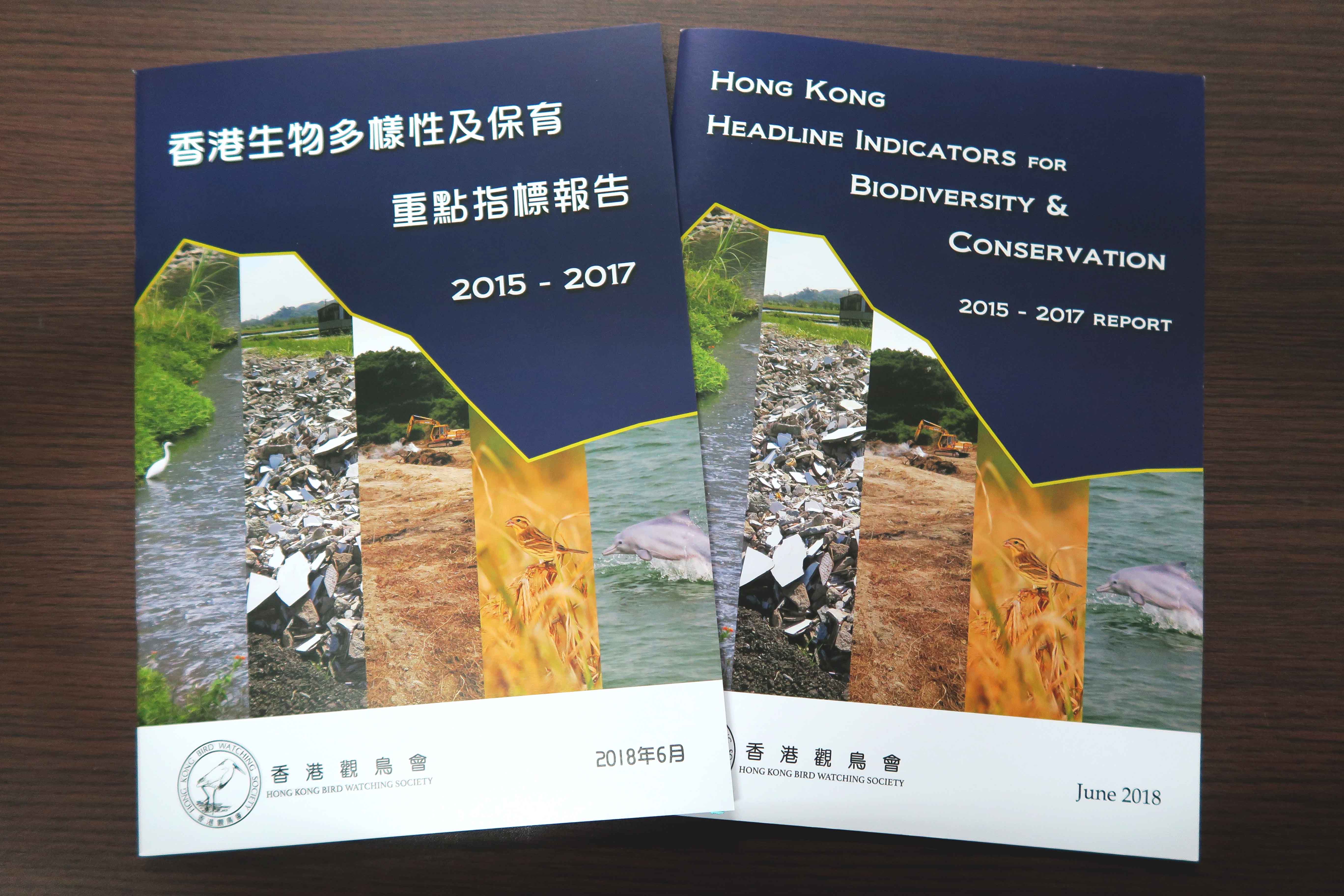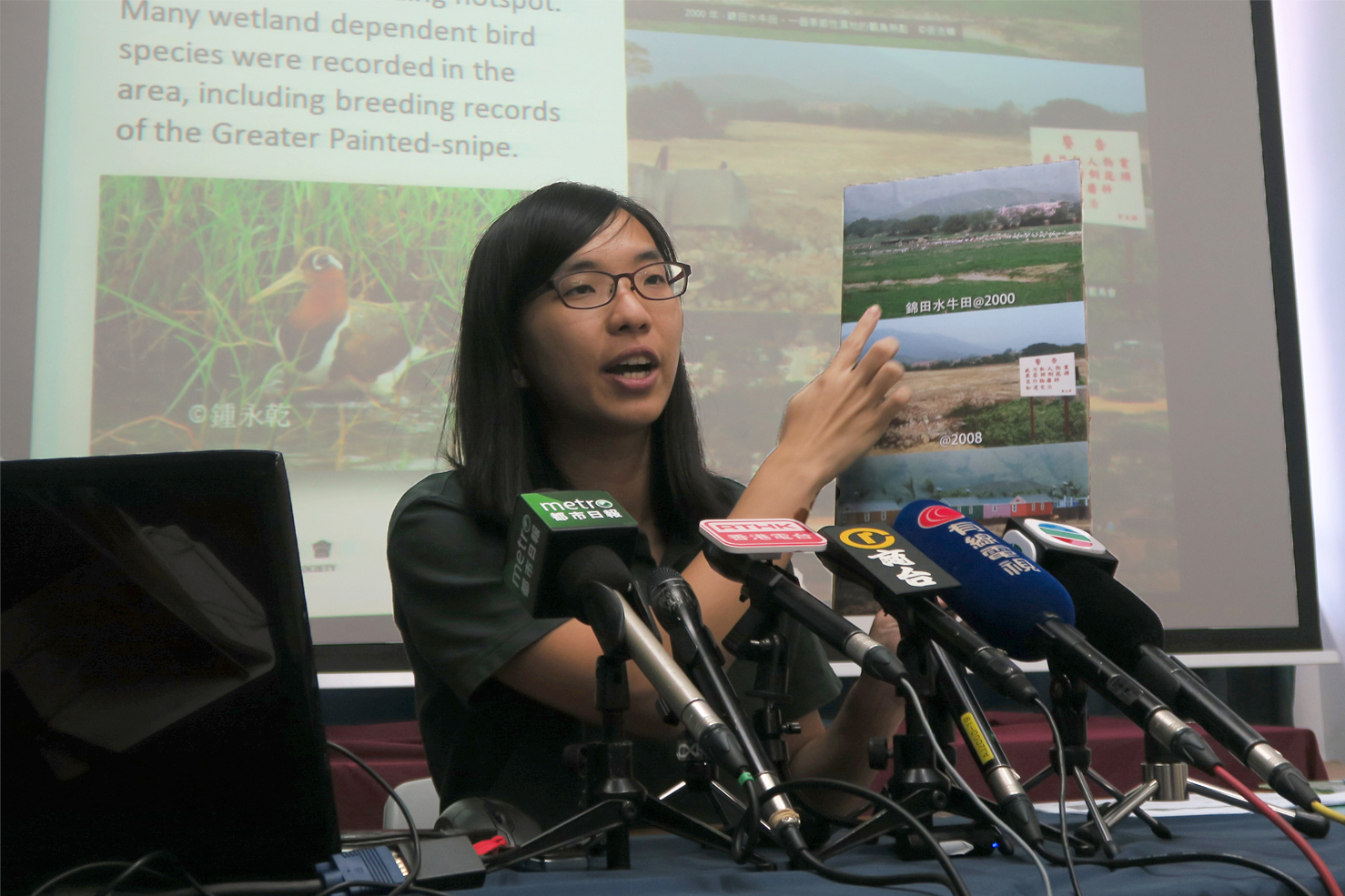|
Conservation Officer Sr Moderator
 
- UID
- 15121
- Posts
- 44
- Digest
- 1
- Credits
- 10
- NickName
-
- Online
- 26 hours
- Registered
- 27/06/2018
- Last login
- 27/03/2025
|
1#
A A
A Post at 2/08/2018 16:21 Show author
重點指標報告顯示保育制度失效 Highlights of Indicator Report

 (2018年8月2日)香港觀鳥會(本會)今天發佈「香港生物多樣性及保育重點指標報告 2015-2017」(報告)。報告指出土地規劃制度已不能有效保護具保育價值的土地,加上經年執法不嚴,正在蠶食本港在生態保育方面所取得的成果。
(2018年8月2日)香港觀鳥會(本會)今天發佈「香港生物多樣性及保育重點指標報告 2015-2017」(報告)。報告指出土地規劃制度已不能有效保護具保育價值的土地,加上經年執法不嚴,正在蠶食本港在生態保育方面所取得的成果。
這份報告為同系列的第四份,運用並分析政府部門及其他可靠途徑提供的數據,是全港唯一一份有系統監察本地生物多樣性保育狀況和進展的報告。
本會主席劉偉民指出:「漁農自然護理署及環境局推出《生物多樣性策略及行動計劃》(《行動計劃》),算是在《生物多樣性公約》(《公約》)下制訂保育框架上邁進一步。可是政府一直無法阻止一些具生態價值的地點被破壞,甚至無法履行保育地帶的規劃意向及準則。種種制度的失效實在有違制訂《行動計劃》的良好意願。 」
報告所顯示的數字再次揭露,不論在現行法規或政府的執法效力上,皆無法遏止環境破壞行為 。縱使「農業」及「綠化地帶」均不宜進行發展,但仍有不少發展申請獲城市規劃委員會批准,獲批比率分別為61%及48% 。
在撰寫這份報告的過程中,本會發現政府有意圖改劃綠化地帶作發展用途的趨勢。綠化地帶的改劃始於前任特首梁振英,並表示只會考慮「沒明顯緩衝作用及保育價值」的綠化地帶。唯事實正正相反,多個擁有茂密植被、為重要物種棲息地及具顯著緩衝價值的綠化地帶被選定作發展用途 。更甚的是,政府似乎企圖重施故技,嘗試開發郊野公園,同樣揚言只會發展「較低生態價值」的地點。
政府不但沒有修正政策和法例上的漏洞以遏止重要生態環境的破壞,更蓄意策動發展一些保育地帶,加速生態上的破壞。此等做法不但違反香港自身的規劃法例和保育政策,亦有違大灣區所倡議的「綠色及健康生活環境」和全國生態保護紅線制度的保育意向,更與國際《公約》的保育精神背道而馳。
(2 August 2018) The Hong Kong Bird Watching Society (HKBWS) today released “Hong Kong Headline Indicators for Biodiversity and Conservation 2015-2017”, which demonstrates how a weakening of planning protection for green zones and years of poor enforcement are undermining significant recent progress in other areas of biodiversity conservation in Hong Kong.
Now in its fourth edition this report uses data from Government departments and other authoritative sources to provide the only systematic review of the state of Hong Kong’s biodiversity effectiveness of the conservation action to protect it.
Mr. Apache Lau, Chairman of HKBWS said, “Agriculture, Fisheries and Conservation Department and Environment Bureau have made progress in launching its Biodiversity Strategy and Action Plan (BSAP) as a broad framework for conservation under the Convention on Biological Diversity (CBD). However their good intentions are being compromised by the Government’s persistent failure to enforce effectively against trashing of ecologically-important sites and its disgraceful undermining of the zoning that protects our biodiversity .”
The data presented in this year’s report again shows that weaknesses both in the laws themselves and in their enforcement is limiting the Government’s ability to prevent the trashing . It also shows that the approval rate by the Town Planning Board of large numbers of developments in Agriculture (61%) and Green Belt (48%) zones - despite the fact that both zonings carry a presumption against development .
During the preparation of this report HKBWS noted an associated trend for the Government to rezone Green Belt sites for development purposes. This process was initiated under former Chief Executive CY Leung, along with assurances that only degraded sites of “insignificant buffering effect and relatively low conservation value”. The reality is very different, with several well-wooded sites that host important species and have significant buffering value being targeted . This issue has become more significant as the Government is now actively seeking to develop land inside Country Parks, with same assurances that only land of low ecological value will be developed .
So the Government has not only failed to initiate the necessary changes in policies and legislation to halt ecological degradation of important habitats, it is actively pursuing the development of sites that will inevitably accelerate the rate of ecological loss. This runs directly contrary to the intent of Hong Kong’s own planning laws and conservation policies, but also the national direction under the Greater Bay Area initiative for a “green and healthy living environment” and the Ecological Protection Red Line system for conservation and the CBD at the international scale.”

 本會高級保育主任胡明川補充:「從政府違反改劃綠化地帶的承諾可見,這種以『相對較低價值』作為選址條件的論述,已得不到公眾的信心。而近年政府有意開發一些『相對較低生態價值及公眾享用價值』的郊野公園,實在令人無法相信政府對自然保育的誠意。我們促請市民不要支持政府將郊野公園作為土地供應選項。這不僅加劇自然保護區的破壞及干擾,更挑戰行之已久的《郊野公園條例》。」
本會高級保育主任胡明川補充:「從政府違反改劃綠化地帶的承諾可見,這種以『相對較低價值』作為選址條件的論述,已得不到公眾的信心。而近年政府有意開發一些『相對較低生態價值及公眾享用價值』的郊野公園,實在令人無法相信政府對自然保育的誠意。我們促請市民不要支持政府將郊野公園作為土地供應選項。這不僅加劇自然保護區的破壞及干擾,更挑戰行之已久的《郊野公園條例》。」
報告亦反映生境的持續破壞如何不間斷威脅本地物種,並導致香港生物多樣性的損失 。后海灣每年最高水鳥數量繼續呈現下降趨勢,而且鷺鳥繁殖地不時遭受破壞,包括最為人熟悉的大埔鷺鳥林修樹事件。再者,多項獲批在北大嶼水域的填海工程令中華白海豚幾乎沒有再在大小磨刀洲一帶水域出沒。
可幸的是《行動計劃》已獲配資源並推行了一些新的保育行動 ,當中的承諾包括:
一、 準備及執行針對郊野公園、特別地區、海岸公園及海岸保護區的生物多樣性管理計劃
二、 編制本港受威脅物種名冊,以便為香港的保育行動提供指引
三、 制訂及檢討物種行動計劃
四、 加強管理外來入侵物種
以上皆有效協助香港管理及保護生物多樣性。此外,保育成效亦見於對外來入侵物種的控制 、打擊非法象牙貿易等有關保護全球瀕危物種的行動 ,以及將自然保育元素融入排水和防洪的工程中 。
本會鼓勵每一位重視自然遺產的市民,在九月二十六日或之前就政府的土地供應諮詢提交書面意見,反對一切會為香港自然環境帶來不可逆轉的破壞的土地選項。政府應立即終止所有環境破壞,並優先考慮及善用其他已開發的土地選項,確保香港的生物多樣性得到有效保護。
報告所採用的重點指標取自於一份由思匯政策研究所於2011年發表的《自然保育:香港的新政策框架》。這些指標是經過多個環保團體、學者、環保顧問、政府官員及其他持份者廣泛討論後所草擬的。而報告所搜集的數據亦來自不同政府部門、環保團體及學界。
Ms. Woo Ming Chuan, Senior Conservation Officer of HKBWS added, “The Government’s track record of rezoning GBs give the public no cause for trust and confidence that its stated intention to develop the Country Parks would be limited to areas with ‘relatively low’ ecological and public enjoyment value. Indeed the failures of process already emerging in relation to the Country Parks further undermine the Government’s sincerity. We urge the public not to select the Country Park option in the land supply consultation, as this would only lead to even more destruction and disturbance to protected areas, and at the same time undermining and challenging the Country Park Ordinance.”
The Report also highlights how ongoing habitat destruction continues to threaten native species, leading to a loss in Hong Kong’s biodiversity . The peak count of waterbirds in the Deep Bay area continues to follow a declining trend, while some nesting colonies of breeding egrets and herons were damaged, including the infamous incident at Tai Po Market egretry. Reclamation works of various approved development projects in North Lantau waters has driven the number of Chinese White Dolphin sightings in the area around the Brothers to zero.
On the plus side, new conservation actions were proposed under the BSAP . These include commitments, supported by funding to:
i. preparation and implement biodiversity management plans in Country Parks, Special Areas, Marine Parks and Marine Reserves,
ii. compile a list of threatened species for Hong Kong to guide conservation actions,
iii. formulate and review species action plans, and
iv. increase the capacity for management of invasive alien species.
These are important steps to effectively manage and protect the biodiversity of Hong Kong. Progress was also made in the control of invasive species , the protection of globally endangered species such as combating the illegal trade in ivory , and mainstreaming biodiversity conservation into drainage and river revitalization works .
The HKBWS encourages members of the public who value Hong Kong’s natural heritage to make written submissions to the Government (deadline: 26 September 2018) to object to the land supply options which would lead to irreversible environmental changes in Hong Kong. It is important to stop the current environmental degradation and consider other developed or formed land options first to ensure effective protection and conservation of Hong Kong’s biodiversity.
The headline indicators in this report were developed based on the report “Nature Conservation: A new policy framework for Hong Kong” published by Civic Exchange in 2011, and were selected through discussions with environmental NGOs, academics, consultants, government officials and other stakeholders. The data used in the report was collected from Government departments, environmental NGOs and academics.
*報告下載:香港生物多樣性及保育重點指標報告 2015-2017
*Report download: Hong Kong Headline Indicators for Biodiversity and Conservation 2015-2017
__________________________________________________________
1 香港生物多樣性及保育重點指標報告 2015-2017 第36-38頁
2 香港生物多樣性及保育重點指標報告 2015-2017 第4-8頁
3 香港生物多樣性及保育重點指標報告 2015-2017 第17-21頁
4 香港生物多樣性及保育重點指標報告 2015-2017 第18-19頁
5 香港生物多樣性及保育重點指標報告 2015-2017 第14頁
6 香港生物多樣性及保育重點指標報告 2015-2017 第25-37頁
7 香港生物多樣性及保育重點指標報告 2015-2017 第35-37頁
8 香港生物多樣性及保育重點指標報告 2015-2017 第23-24頁
9 香港生物多樣性及保育重點指標報告 2015-2017 第9-10, 33頁
10 香港生物多樣性及保育重點指標報告 2015-2017 第22-23頁
1 p.39-40 of the Headline Indicator Report 2015-2017
2 p.5-9 of the Headline Indicator Report 2015-2017
3 p.18-22 of the Headline Indicator Report 2015-2017
4 p.19-20 of the Headline Indicator Report 2015-2017
5 p.14-15 of the Headline Indicator Report 2015-2017
6 p.29-32 of the Headline Indicator Report 2015-2017
7 p.37-39 of the Headline Indicator Report 2015-2017
8 p.25-26 of the Headline Indicator Report 2015-2017
9 p.10-11 and p.35 of the Headline Indicator Report 2015-2017
10 p.23-24 of the Headline Indicator Report 2015-2017
|


